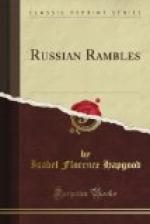She offered to sell us a new petticoat similar to the one which she wore. It was of homespun, hard-twisted wool etamine very durable, of a sort which is made, with slight variations, in several governments. Ordinarily, in this district, it is of a bright scarlet plaided off with lines of white and yellow. A breadth of dark blue cotton is always inserted in the left side. When a woman is in mourning, the same plaid on a dark blue foundation is used. Married women wear coarse chemises and aprons of homespun linen; and their braided hair coiled on top of the head imparts a coronet shape to the gay cotton kerchief which is folded across the brow and knotted at the nape of the neck.
Young girls wear cotton chemises and aprons and print dresses, all purchased, not home made. It is considered that if a girl performs her due share of the house and field work she will not have time to weave more than enough linen for her wedding outfit, and the purchase of what is needed before that unhappy event is regarded as a certificate of industry. I call it an unhappy event because from the moment of her betrothal the prospective bride wears mourning garments. Black beads for the neck are the height of fashion here.
The girl’s gown, called a sarafan, is plaited straight and full into a narrow band, and suspended just below the armpits by cross-bands over the shoulders. She prefers for it plain scarlet cotton (kumatch), or scarlet printed in designs of yellow, white, and green. Her head kerchief matches in style. Her betrothal gown and kerchief have a dark blue or black ground with colored figures.
The bargain for the petticoat was closed at two rubles, its real worth, subject to “sister’s approbation,”—an afterthought on the part of the pretty woman. When she brought it to us at the house, a couple of hours later, modestly concealed under her apron, and with sister’s blessing, she demanded half a ruble more, because we had not beaten her down, and perhaps also as an equivalent for sister’s consent.
She showed us her cottage, which was luxurious, since it had a brick half for winter use, exactly corresponding to the summer half of logs. Behind, in a wattled inclosure, were the animals and farming implements. It was not a cheerful dwelling, with its tiny windows, wall benches to serve as seats and beds, pine table, images in the corner, great whitewashed oven, in which the cooking was done, and on which, near the ceiling, they could sleep, and sheepskin coats as well as other garments lying about.
Practically, a small Russian village consists of one street, since those peasants who live on the occasional parallel or side lanes are “no account folks,” and not in fashion. It seemed inconsistent that ranks and degrees should exist in peasant villages; but human nature is much the same in the country as in capitals, even in the village of the man who advocates absolute equality of poverty, and despite the views of my merry izvostchik Alexei.




